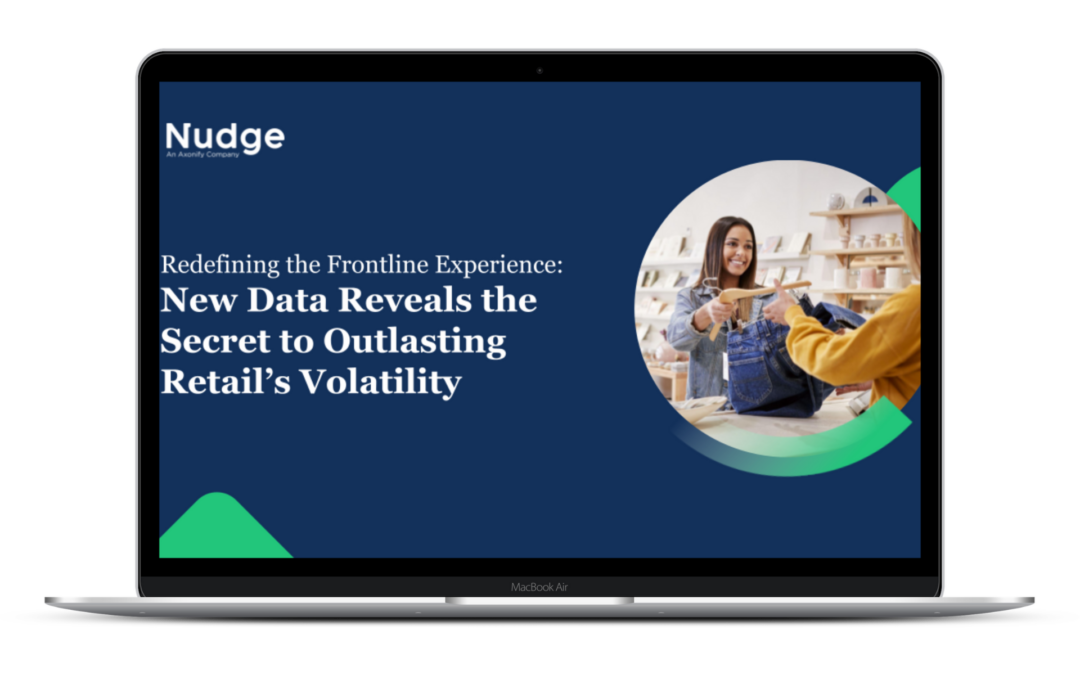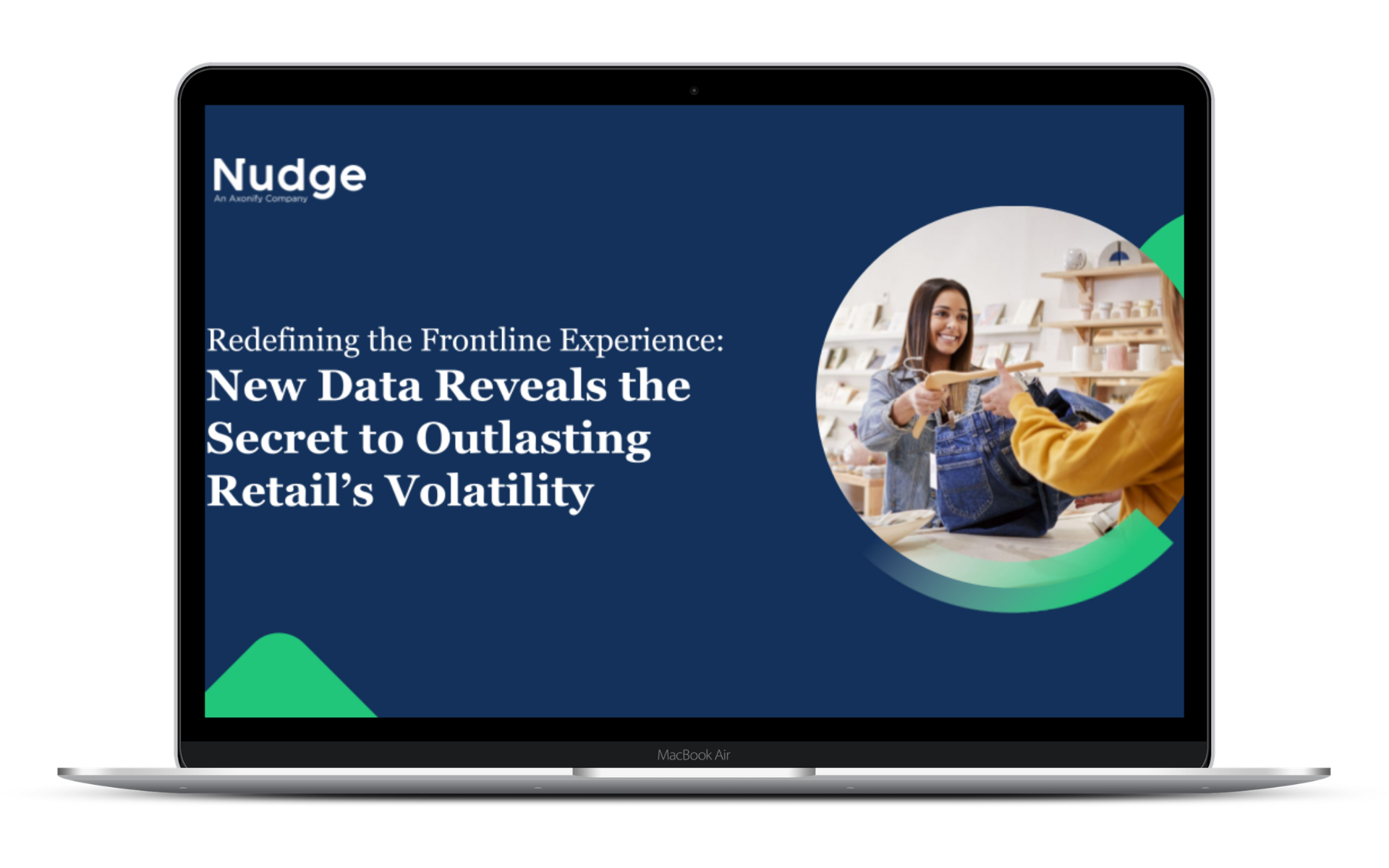
Redefining the Frontline Experience: New Data Reveals the Secret to Outlasting Retail’s Volatility
Redefining the Frontline Experience:
New Data Reveals the Secret to Outlasting Retail’s Volatility

During this webinar, we reveal new findings from Nudge’s annual Deskless Report: Retail Edition, which aggregates insights from managers, workers, and frontline leaders. Get the latest retail-specific data on the critical intermediary role of managers, and what drives associates to perform — and how both can impact the disruptions facing retailers today.
Watch this on-demand webinar to learn how you can apply these findings to:
- Redefine and reimagine the frontline employee experience
- Address key disruptors, like burnout and absenteeism
- Explore the future of frontline enablement technology

The frontline leader’s guide to making data-driven decisions
The frontline leader’s guide to making data-driven decisions
Learn how to collect data and turn it into valuable insights in Nudge's step-by-step guide.
What does every organization want? Better business outcomes. That means higher profits, lower turnover, and better productivity and efficiency. And the key to shifting the needle on these crucial metrics is simple: your workforce.
To set up your organization to thrive, you need to harness the power of your workforce. In order to do that, you need to be making data-driven decisions based on the needs and demands of your workers.
Wondering where to start? This guide will help you understand what data-driven decisions are and why they’re important. We’ll identify what data to collect, how to harvest the metrics, and learn what to do with data.
Data alone doesn’t tell a story. You need to process and analyze those numbers to find trends and correlations. You need to find the story. As Carly Fiorina, former CEO of Hewlett Packard put it, “The goal is to turn data into information and information into insight.”
So, let’s start turning data into insights.
Why do I need to make data-driven decisions?
How engaged is your workforce? How reachable are your teams in uncertain times? How confident are your employees in executing current or future programs and strategies? These aren’t questions to answer with your gut. These are questions that can – and should – be answered with data.
Making data-driven decisions is deeply rooted in workforce analytics. That’s the process of tracking and analyzing key employee metrics to make fact-based, data-driven decisions to improve performance, engagement, and more. This crucial data can help drive better business outcomes across organizations, everything from sales and CX to operational efficiency and productivity.
Why does workforce analytics matter?
Workforce analytics provide organizations with the data and insights to stay agile and responsive, and set up its employees for success. Here are six reasons workforce analytics matter for your frontline or deskless organizations:
1. It drives performance and productivity
Workforce analytics allow you to answer the questions that can inform crucial decisions around performance and productivity. How consistent are locations in implementing SOPs and protocols? What locations are consistently lagging in performance, and why? How confident are my teams in executing a program or promotion?
Using data from feedback forums, confidence checks, and other sources to answer these questions provides the insights you need to tweak policies, implement new processes, and identify worrisome locations or regions quickly and easily – in short, better support your frontline at scale.
2. It identifies key knowledge gaps
Knowledge gaps cause money loss and safety issues, particularly among frontline and deskless employees, who are at greater risk due to less robust training, poor employee communication, and inconsistent processes (fun fact: ineffective on-the-job training can cost businesses up to $13.5 million per 1,000 employees per year).
But with knowledge testing quizzes and pulse surveys, companies can get far more strategic with their training. Through execution metrics, surveys, knowledge quizzes, and other data, analytics can identify knowledge gaps, protocol confusion, and other red flags. From there, organizations can triage their training to address the most urgent needs, then fill out the rest of the program as more resources become available.
3. It mitigates disengagement and turnover
Do you know whether or not your employees are engaged? How can you be sure?
Only 16% of companies use technology to measure and track employee progress and engagement. Those who don’t rely on a combination of observation, anecdotal evidence, gut feeling, and wishful thinking. This means that you don’t know for sure whether or not your frontline and deskless employees – the ones who are in the most stressful positions – are burnt-out or not. And seeing as burnout is responsible for up to half of workforce turnover, this is definitely an area that organizations can’t ignore.
Data from mental health surveys, feedback forums, and other communication channels can help you establish your workforce’s level of burnout and disengagement. Performance and engagement analytics can further inform the potential business impacts of your situation. With these tools in place, you’ll have an early warning system and be able to act accordingly with disengagement strikes.
4. It highlights the trends that lead to better business outcomes
Workforce analytics have the potential to identify trends that could transform your organization.
Here’s an example: Data analysis might discover that one branch of a retail franchise has consistently better sales, higher employee engagement scores, and lower turnover. You might then discover that this branch’s manager has initiated a few new policies that have completely transformed the location. The organization scales these policies company-wide, and numbers across all branches show significant improvement. You would never have detected that outlier branch without looking at the data.
This may seem like a somewhat extreme example, but it’s not that far-fetched. That’s the power of best practice sharing, and people analytics is the channel to capture these valuable ideas at scale.
5. It identifies star performers
The secret sauce to driving key business initiatives – and ensuring continued growth and success on the frontline – comes down to your top-performing employees. But here’s where it gets tricky. You may have thousands, hundreds of thousands, or (why not?) millions of employees across the country, or even the world. How do you identify your top performers? How do you find the fabled needle in the haystack?
Luckily, there are several proven data points that will allow you to gain a better understanding of both potential and active high performers within your workforce, no matter how large that workforce may be.
6. It improves operational execution
You’ve spent 6 months planning a product launch. You’ve executed on the signage, the PR, the inventory. But… are your associates ready? Here’s another area where workforce analytics can have a major impact on business outcomes. Using a customized concoction of data from surveys, check-ins, and skill-testing quizzes, you can create a crystal ball that will tell you how successful your launch will go before it even begins.

Workforce analytics for frontline and deskless teams: a unique challenge
While reviewing workforce analytics is crucial for any company, it becomes especially valuable for deskless organizations with massive employee bases spread across the country – or the world. Collecting and analyzing workforce data allows you to make informed data-driven decisions so that you can boost the efficiency and operational agility of your teams, no matter the size.
What data to collect
The first step of harvesting data for making data-driven decisions is knowing what metrics to collect. Here’s an in-depth list of the employee metrics that all deskless organizations should track on a regular basis. Depending on the communication and feedback tools you have in place, some of these metrics will be easier to capture than others. We’ll get into collecting your data later, but for now, here’s a metrics wish list:
Communication metrics
These metrics will help you gauge how reachable your workforce is and how effective your communication strategies are.
Adoption and reachability
This is a crucial metric for any communication strategy, answering the question, “Who can I reach?” Ideally, the answer would be 100% of your workforce. Depending on the tools you use to communicate with your workforce, your reachability rate can be difficult to nail down. For example, if you communicate by email, you might be able to calculate how many email addresses you have on file, but you don’t know how many are recent, let alone how often they’re checked. At Nudge, we consider employees reachable if they’ve used our app recently, and we’re confident that your messages will reach them.
Knowledge rates
Generated through knowledge testing and quizzes, knowledge rates can show whether the information that has been shared has been properly retained. This helps ensure that you’re identifying knowledge gaps as quickly as possible.
Open/read rates
Again, this will depend on your communication tools and channels, but ideally you have a metric to track how your workforce is consuming content. What percentage of your staff opened your latest announcement? How many read to the end? How many clicked the CTA at the bottom? How often are SOPs accessed and read? These numbers, where available, will help you see whether your content is actually being read by your employees.
Communication engagement
This metric tracks the level of engagement linked to a specific communication campaign, whether it’s an employee experience initiative, like a wellness month, or a new customer promotion or product feature. Ideally, you can quantify this data even more with a campaign engagement rate, calculated by the number of employees who interacted with the campaign compared to the number of employees who received it.
Feedback metrics
These metrics will help you monitor your feedback channels and capture great ideas, no matter how big your organization.
Feedback participation metrics
To get an at-a-glance understanding of whether you’re fostering a culture of feedback across the organization, look at who is regularly engaging with your feedback channels. Depending on the tools you have in place, you can see who is providing feedback through surveys, forums, or other channels. You may also be able to segment these findings by region or location to identify top-participating groups, as well as those that are quieter.
Feedback sentiment
When you’re collecting feedback from hundreds of thousands of employees, it’s important to have ways to quantify their sentiments at scale. This might be done through sentiment analysis, crowdsourcing/upvoting ideas, and numbers-focused feedback (like multiple-choice surveys). Capturing ideas in these formats lets you turn qualitative feedback into quantitative insights to make more data-driven decisions.
Performance metrics
These metrics will help you successfully execute on key events, like promos and product launches, by understanding how prepared and knowledgeable your employees are.
Execution metrics
Depending on your industry and organization, you might be leveraging standardized task lists within your internal communication strategy to reiterate standard protocols and processes.
Employee performance metrics on frequently assigned tasks and their completion rates will indicate the effectiveness and consistency
of your execution.
Campaign success
Closely tied to execution and confidence are metrics related to a specific campaign or key event, like a product launch or a major organizational change. This could be a combination of metrics around reach, knowledge retention, task execution, sales and revenue, and feedback as an indicator of overall campaign success.
Employee confidence
Employees’ confidence is directly related to their ability to fulfill their job requirements, whether that be speaking confidently to customers about a product or service or executing on a specific task. Capturing data around employee confidence through a survey, knowledge quiz, or forum is a critical metric needed to predict the success rate of key events, like promos or launches.
Engagement metrics
These metrics will help you keep a pulse on employee morale and identify red flags around disengagement and turnover.
Employee engagement metrics
Employee engagement metrics can be measured in a variety of ways. They can be an aggregate metric based on how your employees engage with your communication and feedback channels, or it can be based on dedicated surveys and pulse checks.
Voluntary turnover rate
Voluntary turnover tracks the number of people who have left your organization on their own volition against the average number of employees overall. A high turnover rate means that an above-average number of employees are quitting. One important note: What constitutes a “high turnover rate” will vary according to a number of factors, such as location, industry, and your own historical benchmarks.
Employee advocacy rates
Employee NPS? Yes, it’s a thing. It’s essentially asking whether your employees would recommend your company as a good place to work and/or whether they would recommend your company’s products or services to a friend. Tracking employee advocacy is a good way of tracking overall employee engagement.An engaged employee is more likely to be an advocate of your brand. Conversely, if your advocacy levels are low, there are likely engagement issues within the organization that may be negatively impacting productivity or customer service.
How to collect your data
Now that you know which metrics you want to be capturing, how do you capture them? There are a few different ways to collect workforce data depending on the communication tools you have in place. Here are a few methods to consider:
Download the full guide to learn more!
Download the full guide to read more!
Share your details below to get the full guide, which includes step-by-step instructions on turning data into decisions, the data mistakes every organization makes, and much more. Plus: Printable charts and reference sheets!
Thank you for your interest in our ebook. Access the pdf here.
Visit our Resource Hub to explore additional resources for influencing and inspiring your frontline employees to drive meaningful results.
